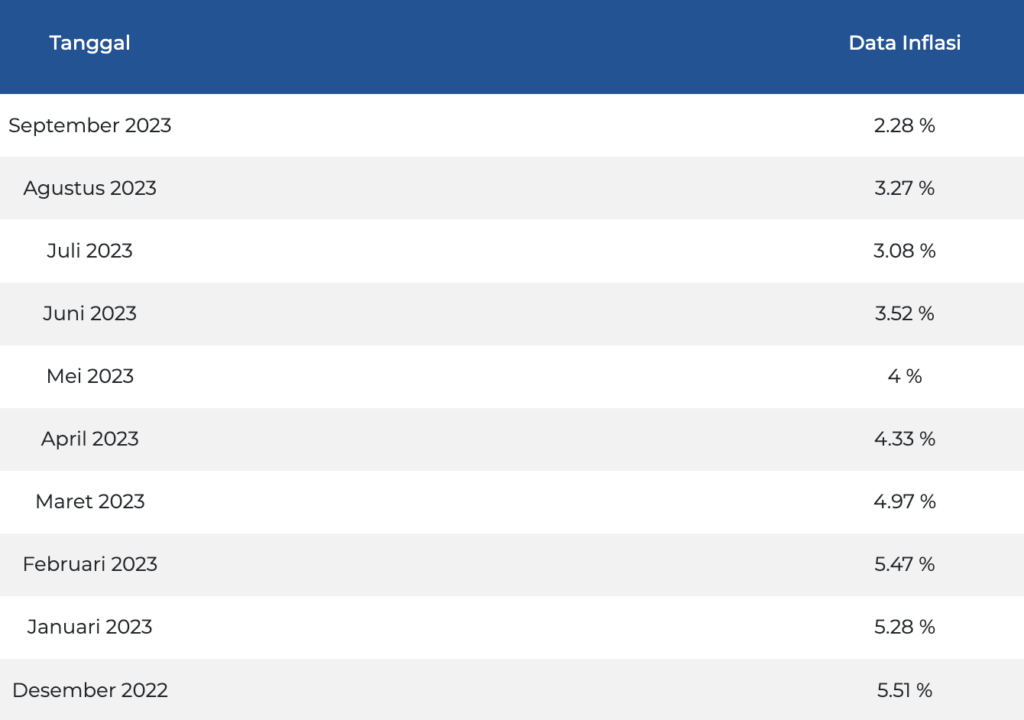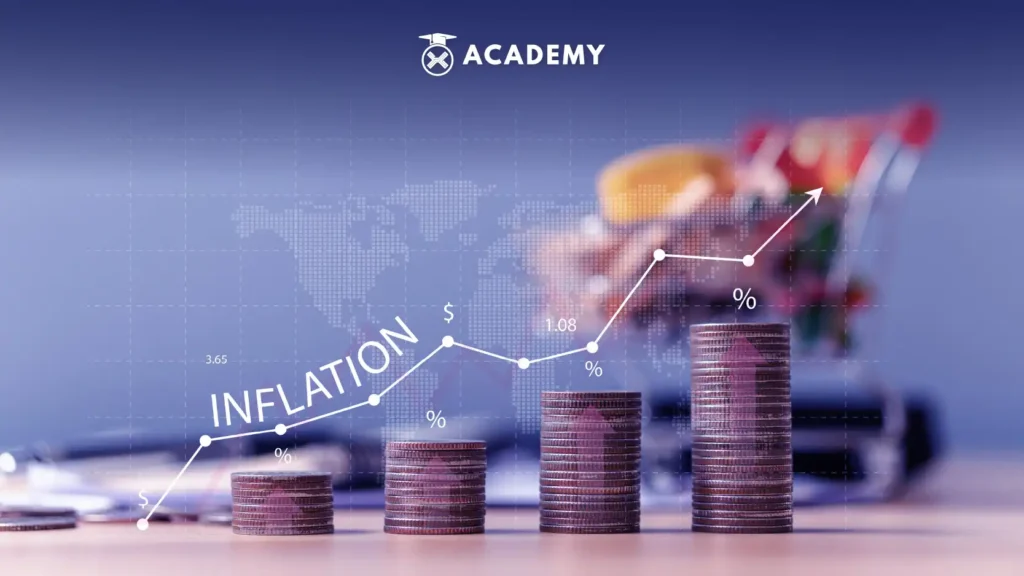The situation of high prices of goods and services within a certain period of time is what inflation means. Unlike the increase in unit prices of goods, this condition cannot be called inflation.
The basis for calculating inflation is collected from price data from surveys of various goods and services that represent public consumption spending which is then compared with price data from the previous period.
What is inflation?
You need to know that inflation is an increase in the prices of goods and services in general and continuously over a certain period of time as quoted from the official bi.go.id website.
Of course, an increase in the price of just one or two goods cannot be called inflation unless the increase is widespread or results in an increase in the prices of other goods.
In general, inflation calculations are carried out by the Central Statistics Agency (BPS) in Indonesia.
BPS conducts surveys to collect price data for various goods and services which are considered to represent public consumption spending. Then this data is used to calculate the inflation rate by comparing current prices with the previous period.
Types of inflation

Inflation is divided into three types of categories, namely inflation based on economic impact, causes of inflation, and its sources.
Inflation based on economic impact
- Mild Inflation
Inflation has not really disturbed the country’s economy and is easy to control with price increases of under 10% per year.
- Moderate Inflation
Inflation can reduce the level of welfare of people with fixed incomes but does not endanger the country’s economic activity by increasing prices by around 10% -30% per year.
- Heavy Inflation
This inflation can disrupt a country’s economy because generally this condition makes people not want to save and prefer to save goods because the interest is much lower than the inflation rate. The price increase for this type of inflation is 30% – 100% per year.
- Very Heavy Inflation (Hyperinflation)
This type of inflation has disrupted a country’s economy and is very difficult to control even if monetary and fiscal policies are implemented. The inflation range for this type is at 100% and above per year.
2. Inflation based on causes
Demand pull inflation
- what is causing inflation A situation when demand for goods or services is higher than producers can fulfill.
Cost push inflation
- Inflation occurs due to an increase in production costs which causes the price of goods to rise.
- Bottle neck inflation
Mixed inflation caused by supply and demand factors.
3. Inflation based on source
Inflation comes from domestic
- Inflation originates from within the country, where the amount of money in society is more than what is needed. A situation where certain goods or services experience a decline while market demand remains and does not decrease so that prices increase.
- Inflation comes from abroad
Inflation originates from abroad because the price of imported goods is becoming more expensive due to the price of goods from the country rising.
Inflation Data in Indonesia

Above is a table of inflation data in Indonesia from December 2022 to September 2023 where in terms of presentation the inflation rate decreased from 5.51% to 2.28% according to Bi.go.id sources.
Differences between Inflation, Deflation and Stagflation
If the prices of goods and services experience a general and continuous increase over a certain period of time, it can be said that inflation is occurring. This inflation can reduce the global economy because high prices cause cuts in retail sales and low people’s purchasing power.
Indonesia itself experienced inflation when fuel oil (BBM) rates increased, which resulted in production costs also increasing. This makes the prices of goods and services such as eggs, chilies and chicken expensive.
Meanwhile, if goods and services continuously decline over a certain period of time, it is called deflation. The definition of deflation itself is an increase in the purchasing power of money over a certain period because the amount of money in circulation is relatively smaller compared to the amount of goods and services available.
This makes people feel they are benefiting because the prices of goods and services are cheap so their expenses can be reduced. However, in reality, this situation is experiencing deflation. A decrease in demand for goods, an increase in the supply of goods, an abundance of the same goods, and a decrease in the amount of money in circulation are characteristics of deflation.
There is a decline in product prices due to unbalanced, dynamic consumption and production power called circulatory deflation. However, if product prices fall due to policies that fail to reduce people’s excessive consumption, this is called strategic deflation.
In September 2019, based on BPS (Central Statistics Agency) data, Indonesia experienced deflation. 82 cities in Indonesia experienced deflation of up to 0.27% due to falling prices of food commodities and kitchen spices
Then, if a country’s economic growth weakens, the unemployment rate is high, and the prices of goods are expensive, this is known as stagflation. High unemployment rates can weaken the purchasing power of the people of a country. Indonesia experienced stagflation in 1998 because the rupiah exchange rate fell against the US dollar. So the price of goods at that time was expensive and the exchange rate for money circulating in society fell.
Factors causing inflation

1. Rising production costs
The increase in production costs occurred due to the high prices of raw materials. This is usually caused by the success of labor unions in raising wages or rising fuel prices.
2. Increase in the amount of money in circulation
If the amount of money in circulation increases, production prices become expensive. Not only that, if the government uses a deficit budget system, it can also increase the amount of money in circulation.
3. Increased demand for goods and services
High government spending, demand for exports, and demand for goods for private needs can increase the demand for goods and services.
4. Devaluation
The loss of value of a country’s currency compared to other currencies can make imports expensive. This situation is called devaluation.
Impact of Inflation
Inflation does have a very serious impact on society, businesspeople, and the country. One of them is that people’s salaries cannot increase, but expenditures or shopping costs increase because the prices of goods or services that are primary needs increase.
Apart from that, inflation also affects people’s interest in saving in banks because the interest on savings deposits becomes small. Plus, there are administration fees every month at the bank, so the interest earned by customers is increasingly minimal.
Inflation also has an influence on people’s investment activities, one of which is crypto investment because inflation affects crypto movements in the short term. When inflation is high, the price of bitcoin and other assets usually decreases. Meanwhile, if inflation slows down, the price of bitcoin and other assets usually increases. An increase in inflation will, of course, be followed by an increase in interest rates.
Meanwhile, if we talk about the long term, one thing that can survive inflation is crypto assets. This is because the availability of bitcoin is limited to 21 million pieces. The number of bitcoins is limited and impossible to increase, making their value relatively stable against inflation.
This is different from fiat currency, where the amount will increase because it is continuously printed by the central bank. This makes it more difficult for fiat money to maintain its value.
People’s purchasing power can also decrease due to inflation, so people become frugal in their shopping. Meanwhile, one of the keys to driving a country’s economy is the result of public consumption. If people reduce spending, it can slow a country’s economic growth even further.
How to overcome the impact of inflation
Here are several ways to overcome the impact of inflation:
Tight monetary policy
Tight monetary policy can control inflation. By increasing interest rates, reducing the supply of money in circulation, and selling government securities to withdraw money from the market, consumption and investment spending can be reduced, so that inflation can be controlled.
Tight fiscal policy
Tight fiscal policy can reduce spending and balance the budget. One of them is by reducing public spending, increasing taxes, and reducing subsidies, which causes inflationary pressure.
Maintain price stability for goods and services
It is important to monitor and regulate commodity prices, which have a significant impact on inflation, including market intervention, stock management, and creating import policies to maintain price stability.
Increasing investment and innovation
High production and efficiency can reduce inflation, for example, by encouraging people to innovate and invest in the economic sector.
Increase production and productivity. By increasing the supply of goods and services, public demand can be met so as not to cause significant price pressure.
Conclusion
In conclusion, inflation is a situation that endangers the world economy. Inflation is divided into three types of categories, namely, inflation based on its economic impact, causes, and sources.
Rising production costs and demand, large amounts of money in circulation, and devaluation are some of the triggers for inflation.
This results in people’s salaries not being able to increase, expenses or shopping costs increasing, and reducing people’s purchasing power.
With the existence of tight monetary and fiscal policies, the stability of prices of goods or services is maintained, encouraging the growth of investment and innovation, and high production and productivity can anticipate inflation.
In this regard, protecting our country from the detrimental effects of inflation is a must. Therefore, we need to pay serious attention to all issues related to inflation and take wise steps in financial management and investment.
In addition to inflation, you can also read other interesting information, such as hyperinflation and the concept of gross domestic product (GDP), in depth at INDODAX Academy.








